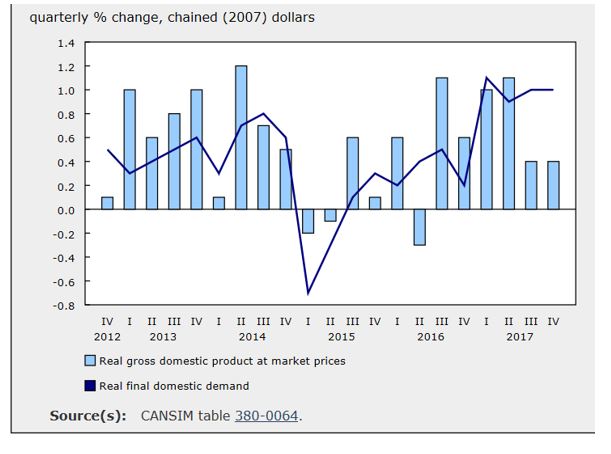The Canadian Economy Gears Down Putting Interest Rates On Hold
Today’s release of 2017 fourth-quarter results confirms the slowdown in the Canadian economy after a rather robust growth spurt in the first half of 2017. The growth rate for the first half of 2017 registered 4.2% (annualized), compared to only 1.6% in the second half. Fourth quarter GDP grew at rate of 1.7% (annualized) while third-quarter growth was revised lower from 1.7% to 1.5%. We have to anticipate this slowdown, knowing that the growth spurt in the first half of the year could not be replicated for the balance of the year.
Quarterly Growth Rates, Canada

These data are from the past. Of greater interest is the economic environment that Canada will face in 2018. In a recent interview on Bloomberg TV, Bank of Canada Governor Stephen Poloz said central banks aren’t going to tighten aggressively because there are still underlying vulnerabilities in many countries. The underlying vulnerabilities in Canada’s case have been identified as:
- One of the highest levels of household debt-to-income in the G-7 countries, largely a reflection of the high cost of homeownership;
- A trade deficit that has widened further in 2017, as traditional energy exports slowdown;
- U.S. - imposed tariffs on steel and aluminium imports and possible further protectionist measures aimed at Canadian exports;
- The entire U.S.-Canada trade picture is clouded by the prolonged and difficult negotiations on revising NAFTA;
- Canada has always relied upon foreign direct investment to boost its domestic economy; however, foreign direct investment in Canada plunged 26 per cent in 2017; foreign firms sold more Canadian companies than they bought for the first time since 2007.
In accepting the Central Bank of the Year Award, Governor Poloz was refreshingly frank when he said [1]
To be truly honest about the uncertainties we face, we stopped providing routine forward guidance, which observers and market participants had come to rely on…This leaves market participants to interpret the data and make their own forecasts about the future path of interest rates. It has taken time, but markets and observers are increasingly adapting to our approach.
As market participants, we expect that for the balance of 2018 interest rates will be held, as Canada adjusts to this difficult international environment.
[1] Central Bank of the Year Award, London, March 1, 2018



